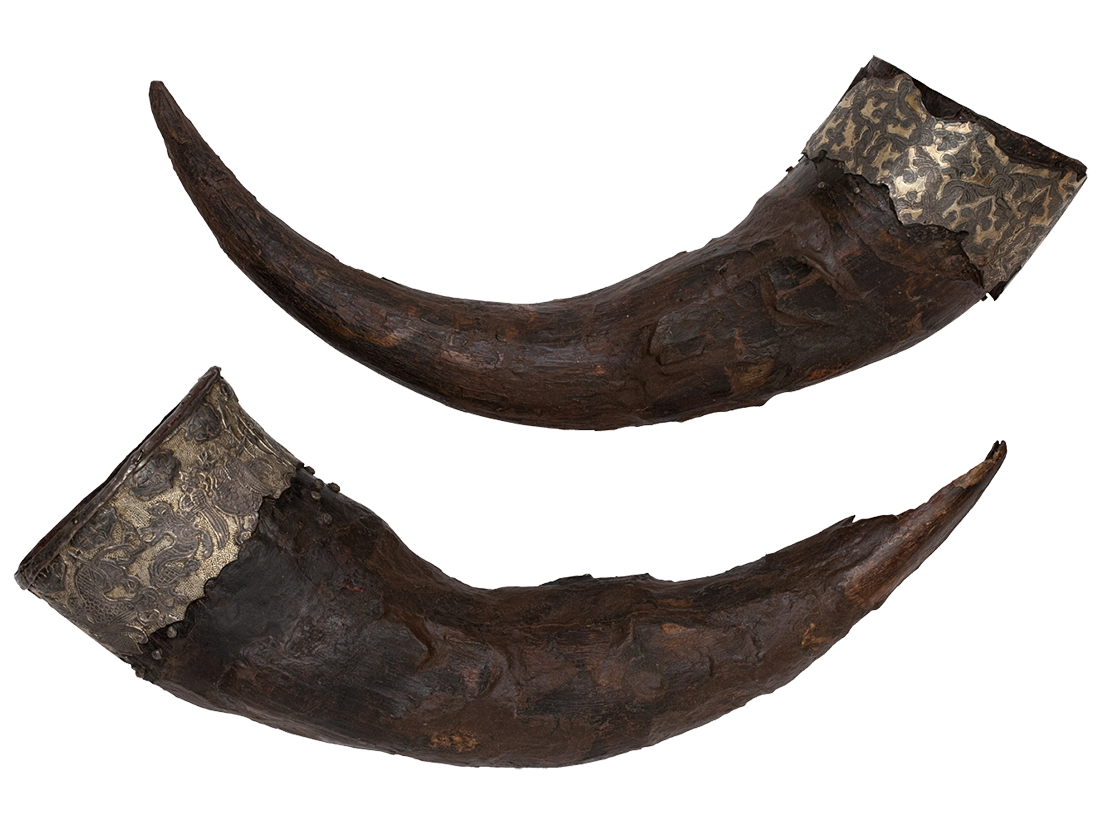Rhytons – drinking horns

The large rhyton – is a drinking horn with a silver covering around its mouth and square cover-plates in the middle part. Binding and cover-plates are decorated with a floral ornament. The floral ornament of the tie-plate around the mouth of the rhyton is combined of three-leafs flowers and their stems inosculate to two- and three-leafs semi-palmettes forming garlands. Details of the ornament are divided by parallel hatchwork. The basis of the composition that decorates square cover-plates in the middle part is formed by four three-leafs flowers framed by a garland of two-leafs semi-palmettes. Details of floral motives are also divided by parallel hatchwork.
Judging by the place where it was found (in the upper layer of the burial mound), it was used during the funeral feast. It was found paired with a small rhyton.
The small rhyton – is a drinking horn with a silver covering around its mouth and square cover-plates in the middle part. Binding and cover-plates are decorated with a floral ornament. The floral ornament of the tie-plate around the mouth of the rhyton is combined of three-leafs flowers and their stems inosculate to two- and three-leafs semi-palmettes forming garlands. Details of the ornament are divided by parallel hatchwork. The basis of the composition that decorates square cover-plates in the middle part is formed by four three-leafs flowers framed by a garland of two-leafs semi-palmettes. Details of floral motives are also divided by parallel hatchwork.
Judging by the place where it was found (in the upper layer of the burial mound), it was used during the funeral feast. It was found paired with the large rhyton.
Drinking horns (rhytons) belong to the epoch of the state formation (IX – the beginning of the XI century) and are exclusionary accessory of the arising Ancient Rus’s elite. Findings of small details of rhytons’ bindings are rare, and a completely remained drinking vessels from the Black Grave are unique.
The “Black Grave” is one of the most majestic burial mounds of Chernigov’s necropolis. In 1872–1873 the burial mound was excavated by famous Russian archeologist Dmitry Yakovlevich Samokvasov. Cremated remains of an adult man, a young man (teenager) and a woman were found in the burial mound.
Dead man were buried with the complete military clothing, they were occupying the central part of the fire-pit (a layer left after the ritual burning). Near the “adult” warrior weapons were placed – two swords, a saber, a spear, a saddle with stirrups, fragments of a chainmail, a helmet, arrow heads, near legs – a shield with cooper binding. Near weapons an iron vessel with rams’ bones and bronze brazier with coals were placed. Near legs of dead men were found remains of two saddled horses.
Bones of the woman were found in the southern part of the fire-pit “at the right hand of man-warriors”. Among objects connected to the woman ten sickles at the foot are. The western part of the fire-pit was occupied by twelve buckets in semicircle from which iron binding and two iron vessels remained.
In the burial many decorations were found, tops of belts, golden and silver ingots – remains of ornaments that melted in the fire, keys, locks, axes, chisels and a bronze vessel with dibs - loaded dice. The presence of game dibs in the burial allowed supposing that one of these noble warriors was still so young that was wearing undersized helmet and played dibs.
The first mound of the burial reached 7 meters in height. Later on the top of it a feast in memory of the dead took place and after it another layer of soil was put over the place. On the very place of the feast were found two rhytons made of aurochs horns with silver richly ornamented binding without signs of being in fire. Likewise on the place of the feast two ritual knifes and a bronze idol of the Scandinavian god Thor were found. These findings highlight the high social status of the dead. Two Byzantium coins also found in the burial mound and according to them the burial mound is dated 960 – the second half of the X century.
Making a mound took a lot of people. Probably, since then the custom that obliges each participant of the funeral ritual to put some soil to the grave, takes its origin.
Chernigov’s necropolis – famous Chernigov’s burial mounds that once bordered city walls and dispersed in rays in directions of major roads – to the south-west, north-east and the north. Size of the necropolis up to date can not be accurately defined, as thousands of burial mounds were destroyed and leveled to the ground.
In 1872, 1878 and 1908 Russian archeologist Dmitry Yakovlevich Samokvasov led research on the territory of the Chernigov’s necropolis. From 550 noted by him burial mounds he excavated 150. In speaking at the XIV Archaeological congress in 1908, the researcher with a great grieve told about the plow up of burial mounds, search for buried treasures and semi-academic excavations made by local historians. Trying to reconstruct the complete size of Chernigov’s necropolis, D.Y. Samokvasov wrote: “Ancient habitants of Chernigov left on the area of approximately 5 versts in diameter, confined by the Desna, the Bilous and the Strizhen rivers, many thousands of pagan burial mounds that cover sites of fire from funeral pyres and burial holes with bones of buried decedents”.
Chernigov is one of the oldest Russian cities. Earliest documents name Chernigov as one of the big cities of Ancient Rus. In a treaty between one of the first Ancient Rus’s princes Oleg and Byzantium emperors Leo and Constantine (year 907) in the list of cities that got contribution from Byzantium Chernigov is mentioned right after Kiev. In the middle of the X century Byzantine emperor Constantine Porphyrogennetos mentioned it among the most important cities of Ancient Rus.
